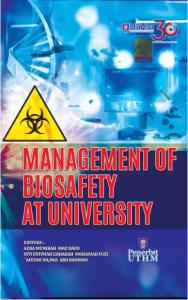MANAGEMENT OF BIOSAFETY AT UNIVERSITY
Keywords:
Biosafety, environment, community, procedures, infectionSynopsis
This manual was developed by the Institutional Biosafety Committee (IBC) of Universiti Tun Hussein Onn Malaysia to provide
information to protect workers and the surrounding environment and to comply with applicable standards and regulations. The planning and the implementation of biohazard controls to prevent laboratory associated infections and to control the spread of contamination must be a part of every laboratory activity in which biohazardous agents are used. The handling of biohazardous agents requires various precautionary measures depending on the agent(s) involved. The purpose of this manual is to provide general guidelines for evaluation, containment, and control of biohazards, categorized as degrees of risk of infection. The implementation of this manual and procedures is the responsibility of the Principal Investigator and the person in charge of each laboratory. It is essential that they seek additional advice and training when needed to conduct research in a safe manner for employees, students, and the surrounding community. To assist in this regard, the Occupational Safety, Health and Environment Office services are available at the university.
Downloads
References
Biosafety Manual (2019). University of Washington, Seattle, USA.
Biosafety Program (2019). The University of Tennessee, Knoxville, USA (https://biosafety.utk.edu/biosafety-program/biosafetymanual/3-biosafety-practices-and-
Laboratory Biosafety Manual (2004). – 3rd ed., World Health Organization.
Laboratory Biosafety Manual (2019). – 4th ed., World Health Organization.
Malaysian Occupational Safety and Health Profile (DOSH/01/2016/OSHPROFILE)
Manjunath, M., Deepak, T. A., Krishna, S., & Bhanushree, R. (2008). Biohazards in dentistry. Journal of Indian Academy of Oral Medicine and Radiology, 20(4), 125.
Pray, C. E., Ramaswami, B., Huang, J., Hu, R., & Bengali, P. (2006). Costs and enforcement of biosafety regulations in India and China.
The Control of Substances Hazardous to Health Regulations 2002. Legislation.gov.uk.http://www.legislation.gov.uk/uksi/2002/2677/
The University of Tennessee Knoxville. (2018). Biohazardous Waste Categories. Biosafety Program. Retrieved on 24 December 2019, from https://biosafety.utk.edu/biosafety-program/waste/
UC San Diego. (2015).How to Identify, Label, Package and Dispose of Biohazardous and Medical Waste. Biohazardous & Medical Waste Retrieved on 23 December 2019, from https://blink.ucsd.edu/safety/research-lab/hazardous-waste/medical/index.html
UC San Diego. (2019). Decontamination Methods for Laboratory Use. Biosafety. Retrieved on 23 December 2019, from https://blink.ucsd.edu/safety/research-lab/biosafety/decontamination/index.html
University of Washington. (2019). Biosafety Manual. Retrieved on 25 December 2019, from https://www.ehs.washington.edu/resource/biosafety-manual-4




